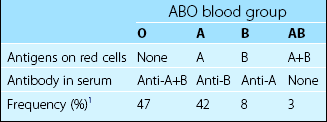41 The most important blood group is the ABO system. The genes encoding the ABO antigens are located on chromosome 9 and are inherited in an autosomal dominant fashion. Each antigen is a sugar residue made by a specific glycosyl transferase. The ABO system is crucial in clinical blood transfusion as there are naturally occurring IgM antibodies in the serum targeted against the non-present ABO antigens (Table 41.1). These antibodies necessitate the use of ABO ‘compatible’ blood for transfusion. For example, the administration of incompatible group A blood to a group B patient would engender a potentially fatal haemolytic transfusion reaction due to the destruction of the donor’s group A red cells by the recipient’s anti-A antibody. Table 41.1 The occurrence of ABO antigens and antibodies Incidences vary greatly in different populations. The objective of routine testing of donated blood is to provide blood which can be selected for likely compatibility with a patient and which contains no identifiable infectious agent (Table 41.2). Antibody testing (e.g. for HIV and hepatitis C) is now supplemented by molecular techniques sensitive enough to trace the virus in the blood before the development of antibodies (i.e. during the ‘window period’).
Blood groups and blood testing
The blood groups

The testing of blood



